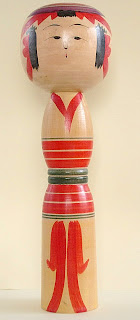"Folksy and Rustic Doll" -Kijiyama kokeshi
Background of Kijiyama Kokeshi
"Kijiyama" = "Kijishi"(woodcrafters) + "yama"(mountains),that is,the name of place originally comes from the history that woodcrafters had lived in the area,mainly in the mountains.As they had been scattered over a wide range in each small group,there are many place called "Kijiyama" in Japan.But "The Kijiyama in kokeshi" is just a certain area in Tohoku - Not all of them had been engaged in kokeshi (about "Kijishi",cf.""Gypsies in Japan").
"Not all of them had been engaged in kokeshi" -it is applied to Kijiyama itself as well.Supposedly,the start of kokeshi production there was not so early,about early 20th.And it came from Naruko,the biggest kokeshi production area.Therefore,early Kijiyama kokeshi were modeled on Naruko kokeshi.And later on,its artisans established their own original style.
Once Kijiyama used to be very popular among kokeshi enthusiasts as a "mecca of kokeshi" because of its mysteriousness -it is located in so deep in the mountains that at that time it was quite out of reach -people always yearn for the unknown with very big fantasy.Now,it has only ten or so artisans.
Shape-shifting Kokeshi?
- craftsman : Kaneichi Sato
- type : Kijiyama
- tall : 25cm(10inch)
- max width : 6cm(2.5inch)
- max circumference : 18cm(7cm)
When I met across her for the first time,I used to think she looked as if she was a stereotyped character in old Japanese fairy tales -in most cases,she played as strange,inscrutable woman,and often changed herself into a "fox" -fox has been
"a symbol of cunning and trickery, or as a familiar animal possessed of magic powers"(quoted from wikipedia) in Japan as well.
Simple is Best!
You can find she puts on an apron -this is "Maedare" in Japanese,and it's one of the most characteristic of Kijiyama kokeshi.But why is such an apron so characteristic?
Authorities say,"this costume was "Sunday best" for girls in Kijiyama region at that time." When I knew it for the first time,I couldn't believe it because it seems just an apron -at least,it is completely different from modern apron dress.And the word "Maedare" has another meaning of "servant" because Maedare was a typical work jumper of servant.This is too modest Sunday best.
Another appearance features are:
- too simple bob cut(in fact,I hesitate to call this hair style "bob cut"...anyway)
- relatively narrow face -in contrast with other type of kokeshi,especially Togatta kokeshi
- half-moon-shaped eyes
And the major difference between Kijiyama kokeshi and others is the physical structure of them. Others are made up of body-part and head- part.That is,artisans make body-part and head-part separately,and join them in the last step.But Kijiyama kokeshi is originally "a unit" -not split into parts.This is simple in terms of its structure,but not easy in terms of crafting process.
The word "simple" is quite an apt remark for Kijiyama kokeshi.I think the girl in the above picture was a typical figure that mirrored the ordinary people of the day.Maybe the girl "Hanako" had to work as a maid away from home to earn money for her poor family.She might be really pushed over,and even needled about her Tohoku accent -that could make her tighter-lipped.
But we don't have to worry about her,because she must change herself into "the rich",not a fox due to her simpleness -like "Oshin",a successful businesswoman from Tohoku.




